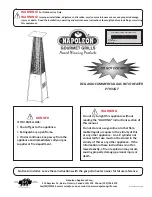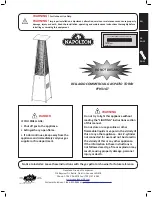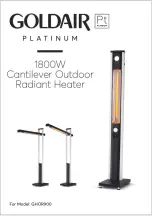
User’s and technical staff manual
Scheme9. Scheme of appliance’s installation
7.2.
Mounting the appliance
7.2.1. Before installing the appliance it is recommended to removing the casing, for this it is necessary to do the following:
a)
Remove the knobs 1 and 2 (see Scheme 1,2) by pulling them towards yourself
b)
Unscrew the panel fixation screw;
c)
Unscrew two screws of casing’s fastening in the bottom part of the appliance;
d)
Disconnect the cables, connecting the display with the electronic control unit and water temperature sensor
e)
Pull the bottom part of the casing towards yourself, move it upwards and remove from the appliance
If the casing or the back wall of the appliance is covered with a protective polyethylene film, it is necessary to remove it before
installation. Also it is necessary to remove the stickers with warning notes and advertising information from the front surface of the
casing (if there are any)
ATTENTION! Do not allow young children play with packaging material because it can be a danger to them. After in-
stalling the appliance the package can be utilized.
7.2.2. The appliance is hanged by the mounting apertures (on the back wall) on two hooks, mounted on the wall (hooks and dow-
els are included into the supply package). Position and sizes of the mounting apertures, also overall and connecting dimensions for
connecting water pipes, gas pipes, and pipes for removal combustion products are presented on the scheme 1, 2.
7.3.
Connecting the appliance to the water supply system
7.3.1. In order to increase the appliance’s working lifespan and improve its exploitation characteristics is recommended to install
a water filter by the appliance’s inlet (see scheme 9)
7.3.2. In order to facilitate further technical maintenance it is necessary to install by the appliance’s inlet a stop valve on the cold
water supply pipeline(scheme 9).The stop valve must be easily accessible.
7.3.3. Connecting appliance to the water supply system should be effectuated with metallic tubes or flexible hoses with inner di-
ameter not less than 13 mm. The length of the flexible hose for water inlet or output should be not more than 2,5 m. Rules of flexible
hoses installation are represented in the p. 7.6.
7.3.4. Cold water connection must be effectuated to the fitting of cold water supply 6, and hot water connection - to the fitting of
hot water outlet 8 (see scheme 1, 2), having previously removed protective gags from the fittings.
7.3.5. Connection of pipes of hot and cold water should not be accompanied by mutual interference of pipes and parts of the ap-
pliance in order to avoid displacement or breakage of separate details and parts of the appliance and disturbance of water system’s air-
tightness.
7.3.6.
Before connecting the appliance to the water supply network it is necessary to open the cold water supply
for some time to clean the pipes of water supply to the appliance and prevent unwanted entering of the contam-
ination and sediments at its first starting up.
7.3.7. After connecting the pipelines to the appliance it is necessary to test joints on air-tightness. Air-
tightness check is done as follows:
a)
Open the hot water tap;
b)
Open the cold water stop valve by the appliance’s inlet;
c)
After filling the appliance’s duct with water, close the hot water tap and examine the joints.
Leakage in the joints is unacceptable. It is also recommended to examine the joints of the appliance’s water
duct, as their air-tightness disturbance is possible in case of the appliance’s transportation and storage con-
ditions violation. Tighten the joints if necessary.
Maximal water pressure the appliance is adjusted to (also in case of water thermal expansion) – 1000 kPа.
Summary of Contents for NEVALUX-5611
Page 28: ......













































